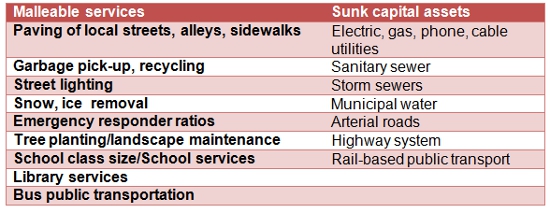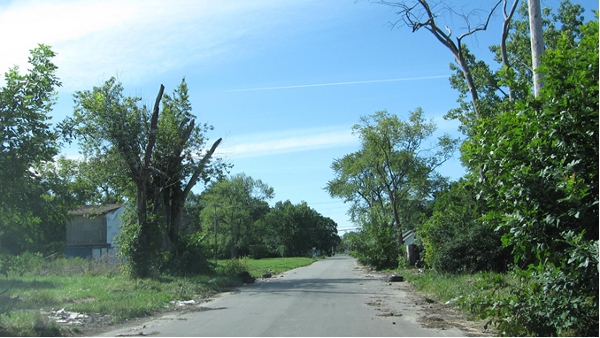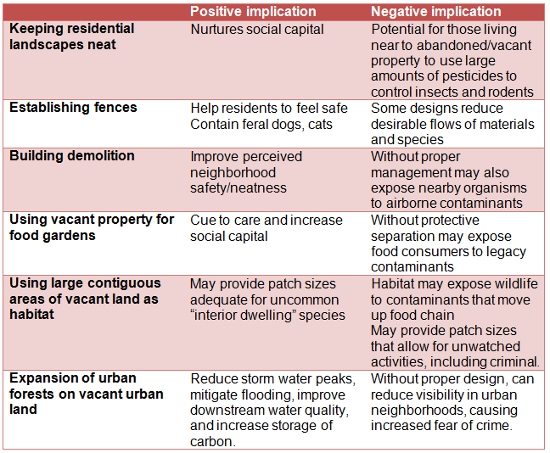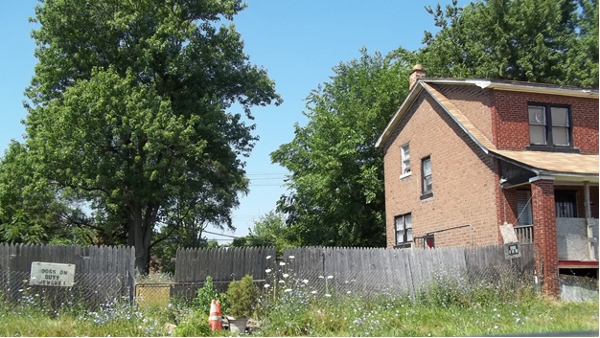 Recent years have placed scenes of urban decay in once successful cities such as Detroit into the popular consciousness. But how can municipalities manage their vacant urban properties in ways that are beneficial to people and the environment, in a fiscally challenging time? Joan Iverson Nassauer writes that urban planners must realize that vacant neighborhoods have not returned to nature and that without the right management, they can undermine human health, economic development, and local ecosystems. She argues that design and planning for highly vacant neighborhoods means that we need to recognize new types of urban landscapes and the associated socio-ecological systems that can be shaped and reshaped to provide environmental and cultural benefits.
Recent years have placed scenes of urban decay in once successful cities such as Detroit into the popular consciousness. But how can municipalities manage their vacant urban properties in ways that are beneficial to people and the environment, in a fiscally challenging time? Joan Iverson Nassauer writes that urban planners must realize that vacant neighborhoods have not returned to nature and that without the right management, they can undermine human health, economic development, and local ecosystems. She argues that design and planning for highly vacant neighborhoods means that we need to recognize new types of urban landscapes and the associated socio-ecological systems that can be shaped and reshaped to provide environmental and cultural benefits.
Vacant and abandoned properties are typical of post-industrial cities, and are not uncommon in urban districts and rural villages around the world. Aging populations, economic decline, real estate miscalculations, natural disasters, and related population migrations drive vacancy. Even in countries with rapid urban growth, vacant buildings and abandoned landscapes dominate some districts. Detroit, Michigan, is the largest and most stunning example in the US. More than a half of all properties are blighted or vacant, occupying an area larger than all parks and open spaces in the city, and a recent report from the Detroit Blight Removal Task Force calls for $850 million to be spent to demolish blighted properties over the next five years.
Management and repurposing of these vacant properties is a fiscal challenge, but could be a design and planning opportunity. In the short term, weak market demand reduces the land development opportunity cost for repurposing highly vacant urban landscapes to provide land extensive ecosystem services – benefits to humans such as flood protection, carbon storage, and habitat – that improve water quality and mitigate or adapt to climate change. If this kind of ecological design of repurposed landscapes aligns with neighborhood values, preferences, behaviors, and dynamics, it may be successful. Furthermore, repurposing to simultaneously meet both ecological and cultural purposes may enhance market values and potential for economic development in the longer term.
Highly vacant neighborhoods are not empty places or places that have “returned to nature”. Without the right management, vacancy can undermine human health, economic development opportunities, and the ecosystem services. However, with the right design and management, they can provide ecosystem services. In Detroit, vacant land tends to become more forested over time. This may reduce urban heat island effects, improve downstream water quality, reduce downstream erosion and flooding, increase carbon storage, and sometimes enhance biodiversity. However, design and management is needed to simultaneously sustain these ecosystem services and make the neighbourhood look safe and well-cared-for.
Across the broader scale of the city, vacancy upsets the balance between infrastructure services and revenues; efficiencies of scale are lost in a patchy pattern of demand. With vacancy, local governments in the United States have more land to manage – because of property received through tax foreclosures – and less revenue to do so. The area serviced per rate payer increases. Especially for services based on sunk capital assets, like storm water management, sanitary sewer. and water supply, the number of rate payers citywide may decline below a minimum required for maintaining facilities that were scaled to larger populations. This infrastructure cannot simply be abandoned even in areas that appear to be entirely vacant. A pressing question is how to reduce and spatially redistribute some of more public malleable services, given the sunk asset infrastructures (Table 1).
Table 1 – Malleable services and sunk asset infrastructure in highly vacant urban districts

General disrepair of these systems can have environmental effects. For example, the problem of combined sanitary and storm sewer overflows (CSOs) polluting downstream waters is typical in post-industrial cities of the US, including Chicago, Detroit, and New York City. In addition, leakage from aging water system pipes alters their groundwater hydrology.
Vacant lands, and their legacy, and social and environmental systems
Urban landscapes that are vacant often have a legacy of contamination from past uses. Even demolition introduces environmental uncertainties related to fate and transport of contaminants that exist on abandoned property. Contaminants incorporated in structural materials may include asbestos, PCBs, lead, zinc and copper. Past occupants may have introduced PAHs from gasoline and oil, several heavy metals from tires and vehicle part repair, and organochlorides and pesticides from pest control. The context of the landscape also contributes to contaminant burden. For example, a location near an arterial street or highway increases likelihood of lead in the soil, a legacy of the decades when it was added to gasoline. Location downwind from a long-time industrial site could increase the likelihood of other airborne contaminants in soil, including mercury.
Figure 1 – To some eyes, this vacant property in Detroit may take on the appearance of “nature”, but it carries the legacy of occupancy by an industrial society.

Photo credit: M. E. Dewar
Landscapes that look “natural” to the unknowing eye may harbor contaminants that are subject to bioaccumulation up the levels of the food chain. Regulation of contaminants in development of brownfield sites has become increasingly stringent in the US – illustrating that scientific knowledge of contaminant risks changes with time.
Vacant lands and social capital
Recognizing the social capital that current residents have invested in highly vacant neighborhoods builds a foundation for change. Residents’ behavior to make their neighborhood landscapes look more well-cared-for, more safe, or more sociable, or to be more productive or useful, may also change flows of contaminants, water, or species. At the same time, institutional investments to manage water (e.g., green infrastructure), demolition programs, disinvestment in infrastructure maintenance, or removal of malleable services may affect residents’ perceptions of neighborhood maintenance, safety, or sociability.
Vacancy presents particular challenges to the social networks that can nurture social capital. People living in homes surrounded by large vacant areas are physically isolated from remaining neighbors, and when vacant landscapes look disorderly, residents perceive increased risk of crime. They may feel increasingly hopeless, stigmatized, and isolated, all of which undermine neighborhood social capital. People who are more vulnerable in some way (e.g., the elderly, children, single parents) may feel particularly at risk. In contrast, landscape characteristics that signify order, care, neighborliness, and an ongoing human presence may encourage social networks and social cohesion. Our research suggests that cues to care that may promote place attachment can include mown turf, trimmed trees and hedges, food gardens, colorful flowers, fences, structures in good repair, neatness and order (no litter, no weeds, no stray items), and furniture for sitting on front steps or porches.
Residents of highly vacant neighborhoods can establish this physical evidence of social capital with little financial capital. Furthermore, institutional investments can establish physical evidence of social capital as part of capital improvement projects that may be primarily intended to improve storm water management or transportation.
Implications for management, design and planning
Individual properties that exhibit strong physical evidence of social capital may have a halo effect – increasing the degree to which nearby properties are perceived as “watched” and reducing dumping of unknown substances on those properties. This halo effect may also reduce the propensity of neighbors to move, maintaining a more spatially cohesive pattern of neighborhood care and perceived safety. Conversely, abandoned properties may produce a destructive halo, inviting destructive activities into the neighborhood and “driving” neighbors to move. Table 2 gives some further possible implications:
Table 2 – Implications for management, design and planning in highly vacant urban districts

Design and planning for highly vacant neighborhoods will require that we recognize new types of urban landscapes and associated socio-ecological systems. For example, the new wave of residential demolitions in Detroit will be targeted to neighborhoods where abandoned properties might have a destructive halo effect on well-functioning neighborhoods. This raises concerns that the most vacant neighborhoods of the city have crossed a threshold into a socio-ecological regime in which ecosystem services may overshadow social effects in landscape management decisions in highly vacant neighborhoods. For example, land-based green infrastructure for distributed storm water management is well-suited to large contiguous areas of vacant land. However, if design and planning of green infrastructure fails to recognize highly vacant neighborhoods as social systems, both long-term storm water benefits and potential social benefits may be jeopardized.
Figure 2 and 3 – Residents of these homes in Detroit adapted to vacancy by different forms of management of adjacent vacant properties.


Photo credit: M. E. Dewar
Novel ecosystems have emerged in highly vacant neighborhoods: people are exposed to personal safety and environmental risks, demolitions are underway, and gardens are being tended. Legitimate approaches to addressing the questions I have raised will probe the highly dynamic and patchy pattern of vacant landscapes in a way that is attentive to the health, safety and welfare of the people who live there and respects the extraordinary value of local social capital.
This article is based on the paper, ‘Urban vacancy and land use legacies: A frontier for urban ecological research, design, and planning’ in Landscape & Urban Planning.
Please read our comments policy before commenting.
Note: This article gives the views of the author, and not the position of USApp– American Politics and Policy, nor of the London School of Economics.
Shortened URL for this post: http://bit.ly/1xaURbq
_________________________________
 Joan Iverson Nassauer – University of Michigan
Joan Iverson Nassauer – University of Michigan
Joan Iverson Nassauer , Professor, School of Natural Resources and Environment at the University of Michigan, develops ecological design schemes for both urban and agricultural landscapes and works in transdisciplinary teams to assess their social and environmental performance. Her books Placing Nature and From the Corn Belt to the Gulf overview some of her work.






